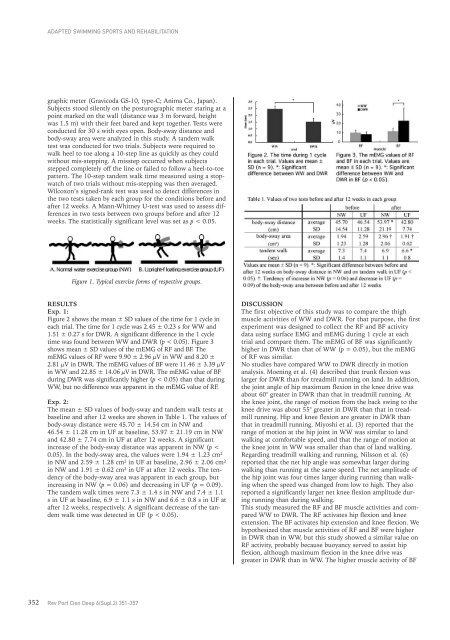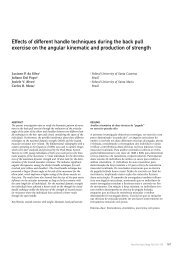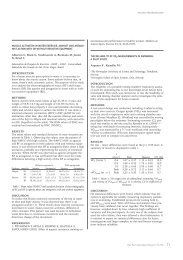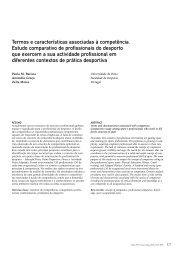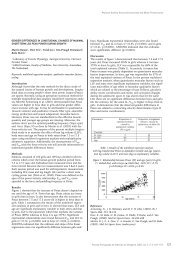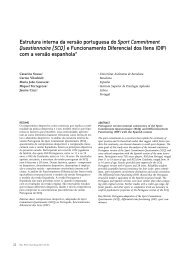adapted swimming sports and rehabilitation
adapted swimming sports and rehabilitation
adapted swimming sports and rehabilitation
You also want an ePaper? Increase the reach of your titles
YUMPU automatically turns print PDFs into web optimized ePapers that Google loves.
352<br />
ADAPTED SWIMMING SPORTS AND REHABILITATION<br />
graphic meter (Gravicoda GS-10, type-C; Anima Co., Japan).<br />
Subjects stood silently on the posturographic meter staring at a<br />
point marked on the wall (distance was 3 m forward, height<br />
was 1.5 m) with their feet bared <strong>and</strong> kept together. Tests were<br />
conducted for 30 s with eyes open. Body-sway distance <strong>and</strong><br />
body-sway area were analyzed in this study. A t<strong>and</strong>em walk<br />
test was conducted for two trials. Subjects were required to<br />
walk heel to toe along a 10-step line as quickly as they could<br />
without mis-stepping. A misstep occurred when subjects<br />
stepped completely off the line or failed to follow a heel-to-toe<br />
pattern. The 10-step t<strong>and</strong>em walk time measured using a stopwatch<br />
of two trials without mis-stepping was then averaged.<br />
Wilcoxon’s signed-rank test was used to detect differences in<br />
the two tests taken by each group for the conditions before <strong>and</strong><br />
after 12 weeks. A Mann-Whitney U-test was used to assess differences<br />
in two tests between two groups before <strong>and</strong> after 12<br />
weeks. The statistically significant level was set as p < 0.05.<br />
Figure 1. Typical exercise forms of respective groups.<br />
RESULTS<br />
Exp. 1:<br />
Figure 2 shows the mean ± SD values of the time for 1 cycle in<br />
each trial. The time for 1 cycle was 2.45 ± 0.23 s for WW <strong>and</strong><br />
1.51 ± 0.27 s for DWR. A significant difference in the 1 cycle<br />
time was found between WW <strong>and</strong> DWR (p < 0.05). Figure 3<br />
shows mean ± SD values of the mEMG of RF <strong>and</strong> BF. The<br />
mEMG values of RF were 9.90 ± 2.96 µV in WW <strong>and</strong> 8.20 ±<br />
2.81 µV in DWR. The mEMG values of BF were 11.46 ± 3.39 µV<br />
in WW <strong>and</strong> 22.85 ± 14.06 µV in DWR. The mEMG value of BF<br />
during DWR was significantly higher (p < 0.05) than that during<br />
WW, but no difference was apparent in the mEMG value of RF.<br />
Exp. 2:<br />
The mean ± SD values of body-sway <strong>and</strong> t<strong>and</strong>em walk tests at<br />
baseline <strong>and</strong> after 12 weeks are shown in Table 1. The values of<br />
body-sway distance were 45.70 ± 14.54 cm in NW <strong>and</strong><br />
46.54 ± 11.28 cm in UF at baseline, 53.97 ± 21.19 cm in NW<br />
<strong>and</strong> 42.80 ± 7.74 cm in UF at after 12 weeks. A significant<br />
increase of the body-sway distance was apparent in NW (p <<br />
0.05). In the body-sway area, the values were 1.94 ± 1.23 cm 2<br />
in NW <strong>and</strong> 2.59 ± 1.28 cm 2 in UF at baseline, 2.96 ± 2.06 cm 2<br />
in NW <strong>and</strong> 1.91 ± 0.62 cm 2 in UF at after 12 weeks. The tendency<br />
of the body-sway area was apparent in each group, but<br />
increasing in NW (p = 0.06) <strong>and</strong> decreasing in UF (p = 0.09).<br />
The t<strong>and</strong>em walk times were 7.3 ± 1.4 s in NW <strong>and</strong> 7.4 ± 1.1<br />
s in UF at baseline, 6.9 ± 1.1 s in NW <strong>and</strong> 6.6 ± 0.8 s in UF at<br />
after 12 weeks, respectively. A significant decrease of the t<strong>and</strong>em<br />
walk time was detected in UF (p < 0.05).<br />
Rev Port Cien Desp 6(Supl.2) 351-357<br />
DISCUSSION<br />
The first objective of this study was to compare the thigh<br />
muscle activities of WW <strong>and</strong> DWR. For that purpose, the first<br />
experiment was designed to collect the RF <strong>and</strong> BF activity<br />
data using surface EMG <strong>and</strong> mEMG during 1 cycle at each<br />
trial <strong>and</strong> compare them. The mEMG of BF was significantly<br />
higher in DWR than that of WW (p = 0.05), but the mEMG<br />
of RF was similar.<br />
No studies have compared WW to DWR directly in motion<br />
analysis. Moening et al. (4) described that trunk flexion was<br />
larger for DWR than for treadmill running on l<strong>and</strong>. In addition,<br />
the joint angle of hip maximum flexion in the knee drive was<br />
about 60° greater in DWR than that in treadmill running. At<br />
the knee joint, the range of motion from the back swing to the<br />
knee drive was about 55° greater in DWR than that in treadmill<br />
running. Hip <strong>and</strong> knee flexion are greater in DWR than<br />
that in treadmill running. Miyoshi et al. (3) reported that the<br />
range of motion at the hip joint in WW was similar to l<strong>and</strong><br />
walking at comfortable speed, <strong>and</strong> that the range of motion at<br />
the knee joint in WW was smaller than that of l<strong>and</strong> walking.<br />
Regarding treadmill walking <strong>and</strong> running, Nilsson et al. (6)<br />
reported that the net hip angle was somewhat larger during<br />
walking than running at the same speed. The net amplitude of<br />
the hip joint was four times larger during running than walking<br />
when the speed was changed from low to high. They also<br />
reported a significantly larger net knee flexion amplitude during<br />
running than during walking.<br />
This study measured the RF <strong>and</strong> BF muscle activities <strong>and</strong> compared<br />
WW to DWR. The RF activates hip flexion <strong>and</strong> knee<br />
extension. The BF activates hip extension <strong>and</strong> knee flexion. We<br />
hypothesized that muscle activities of RF <strong>and</strong> BF were higher<br />
in DWR than in WW, but this study showed a similar value on<br />
RF activity, probably because buoyancy served to assist hip<br />
flexion, although maximum flexion in the knee drive was<br />
greater in DWR than in WW. The higher muscle activity of BF


